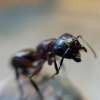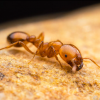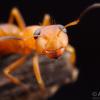How do you guys assess your humidity levels? I'm always on the dryer side. Perhaps I should be on the wetter side of things. I notice in some of the online AC vids (forgive me I just like ant videos) that his nests can be pretty moist. So what keys do you use to know when and how much water to add to your nest?
For example, Crystals stated that Camponotus novaeboracensis prefer "Mid humidity level of 30-50%" I'm focusing on this colony now of mine. However, I'm just trying to get it right and it's hard to gauge.
AnthonyP163 states that C. cerasi prefer a " Recommended Humidity : 40-50%" Another colony of mine. He also states, "30 - 40%, not too much but they still need some" for Teramorium sp. (I'm raising these gals too. I moved them today and they immediately snuggled up to the cotton in my omni nest.
I also have a Formica neorufibarbis colony on the go - about 25 workers.
So how do you gauge humidity percentages?
Also, how about aeration of the formicarium? I actually blew some air into my Camponotus formicarium the other day. Maybe its too stuffy? Yeah....they didn't like that! lol. But they settled down. I notice a bunch hang out near a plugged entrance. This is an AC nest plug and has holes in it for air to vent through. Just not sure. I hate a stuffy room but then again I'm not an ant. I'm sure some of you may be invasive ant aliens, but I can't prove that. ![]()
So, what say you? What methods do you use and do you air (err, lol) on the side of caution with slightly more damp or slightly less damp?
Thanks to Crystals and AnthonyP136 for the ant keeping info!
Any information from all is always appreciated!















